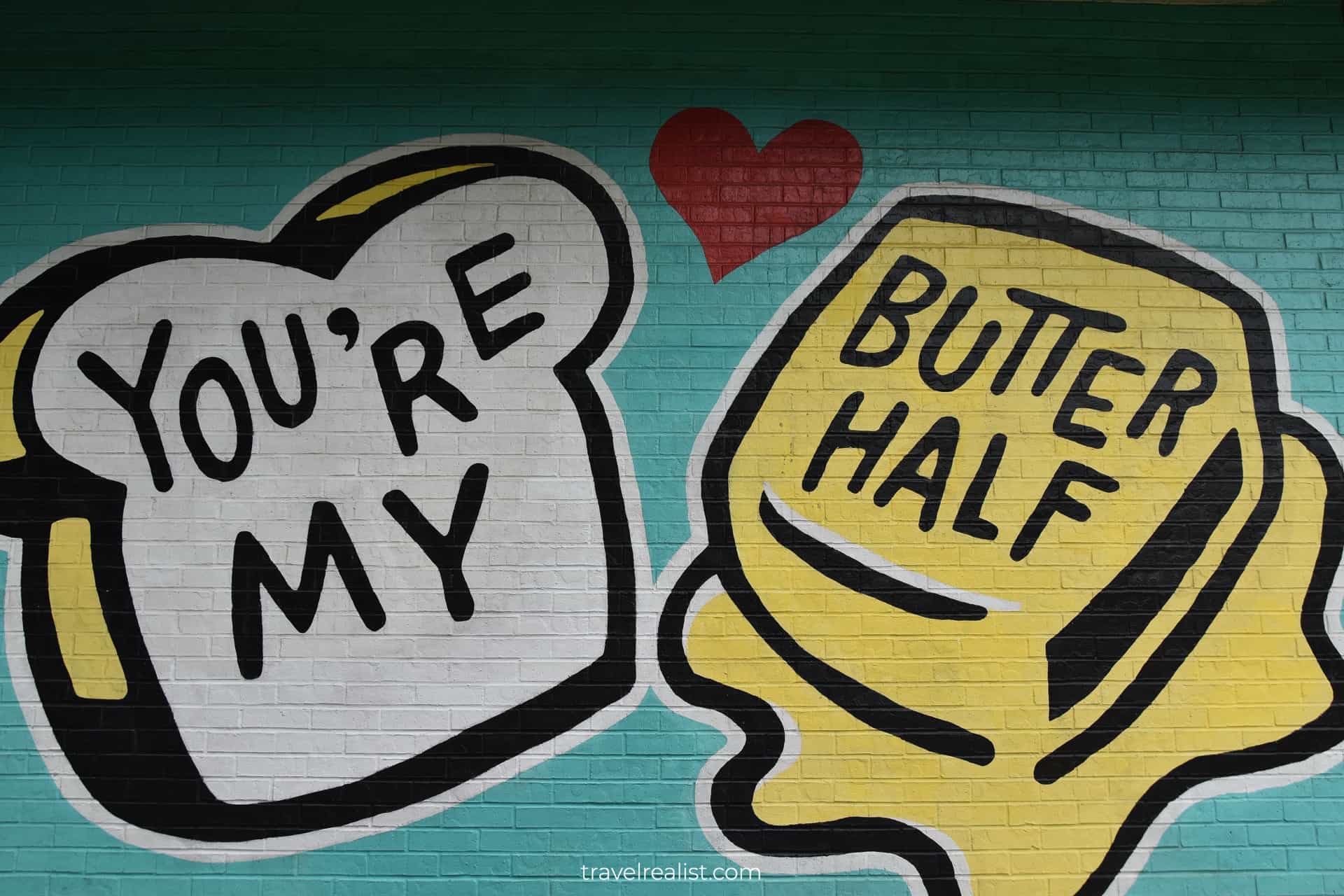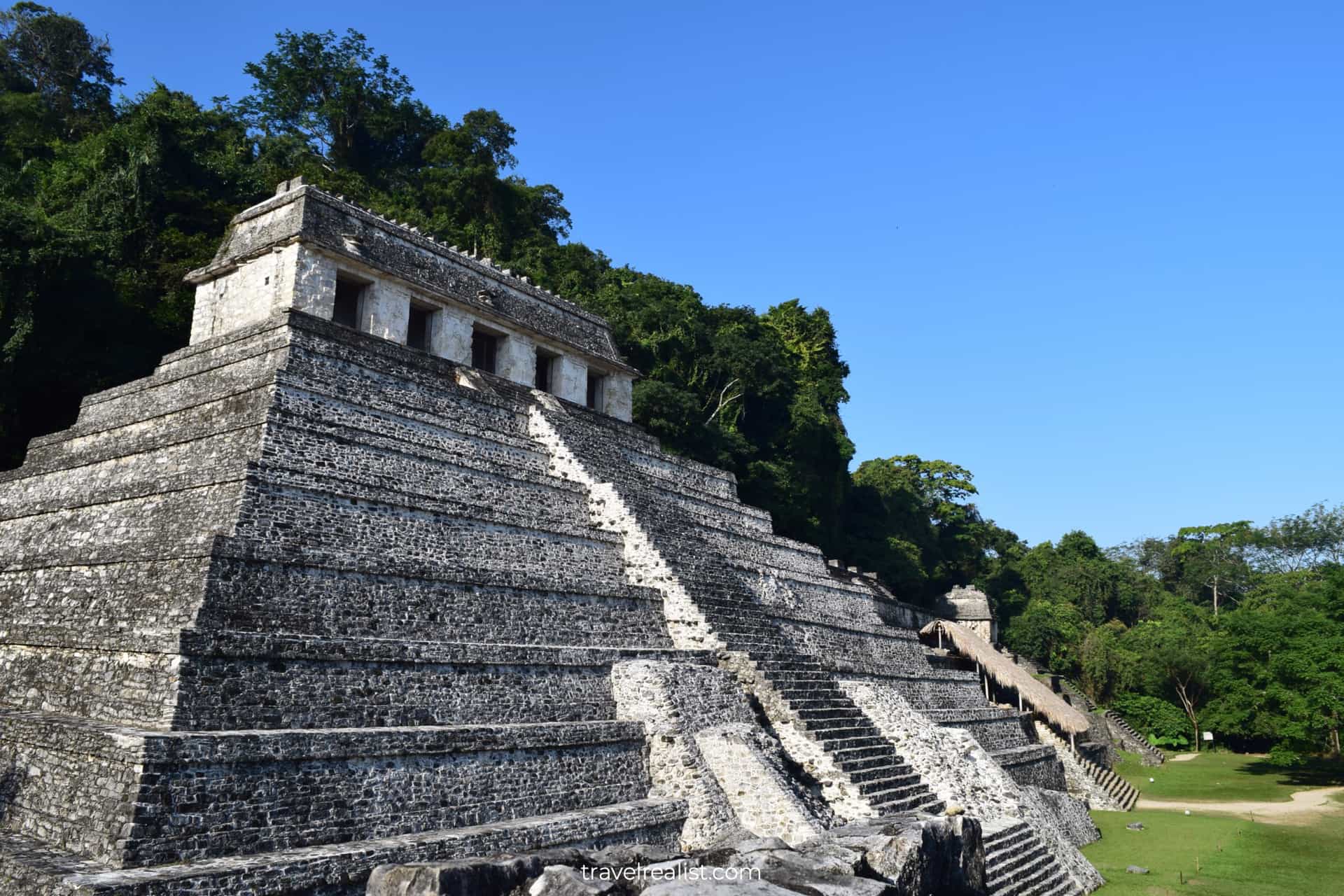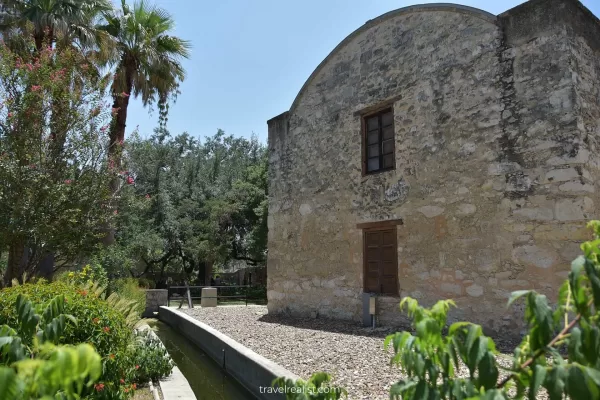Library of Congress: A Visitor Guide to Thomas Jefferson Building
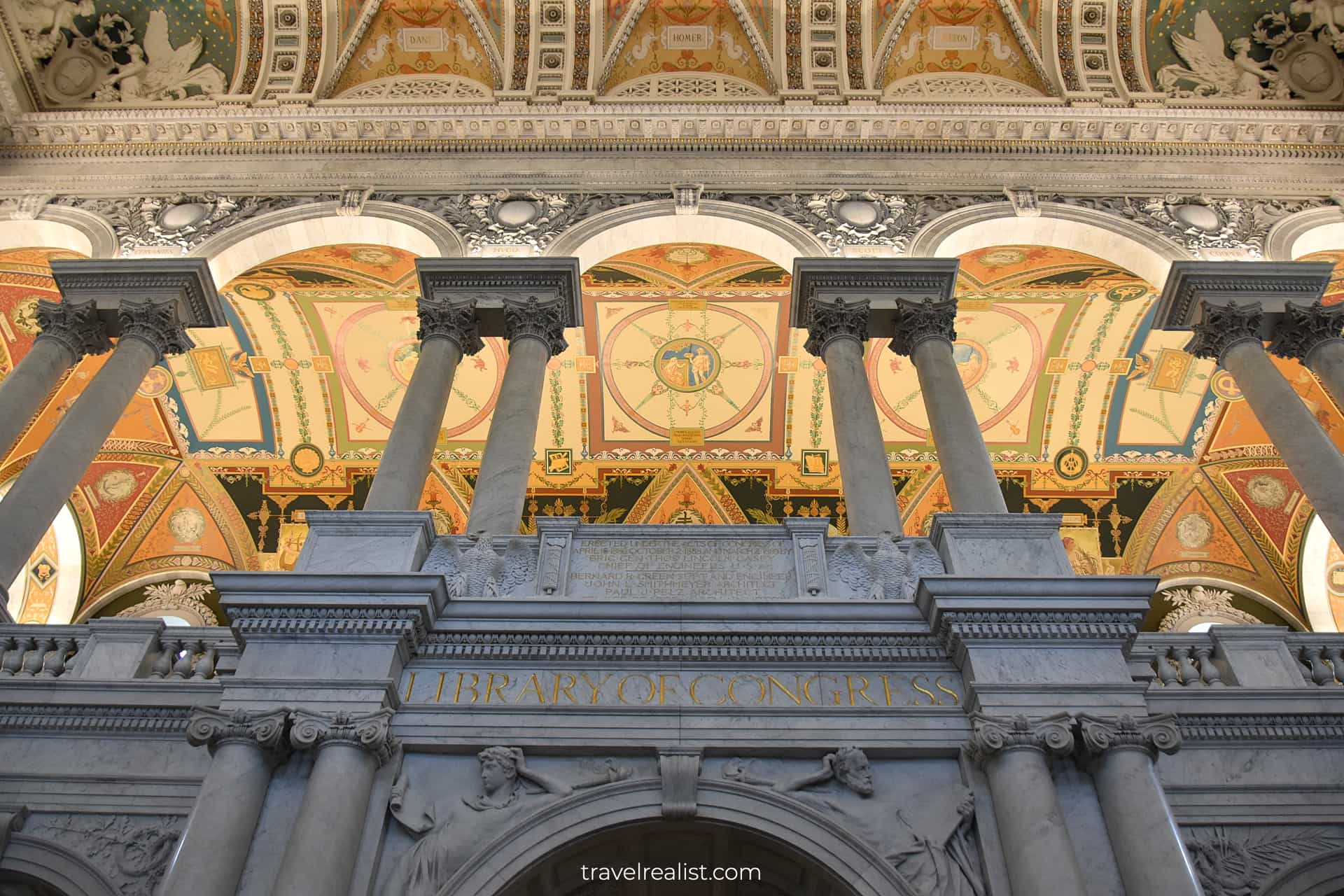
This realistic Library of Congress Visitor Guide helps you plan your next visit to the Thomas Jefferson Building.
The Library of Congress is among the largest libraries in the world. It is also the oldest federal cultural institution in the United States. Some 2 million people visit the Library of Congress every year.
This post includes affiliate links that will earn us commission if you make a purchase via these links.
The Library of Congress has three buildings on Capitol Hill. There are the Thomas Jefferson Building, James Madison Memorial Building, and John Adams Building.
Yet, when most tourists talk about the Library of Congress, they refer to the Thomas Jefferson Building. Some also call this Beaux-Arts building the Main Library.
It is the oldest building of the three. The Main Library dates back to 1897, almost 100 years after the Library was founded. This Visitor Guide aims to simplify your visit to the Library of Congress.
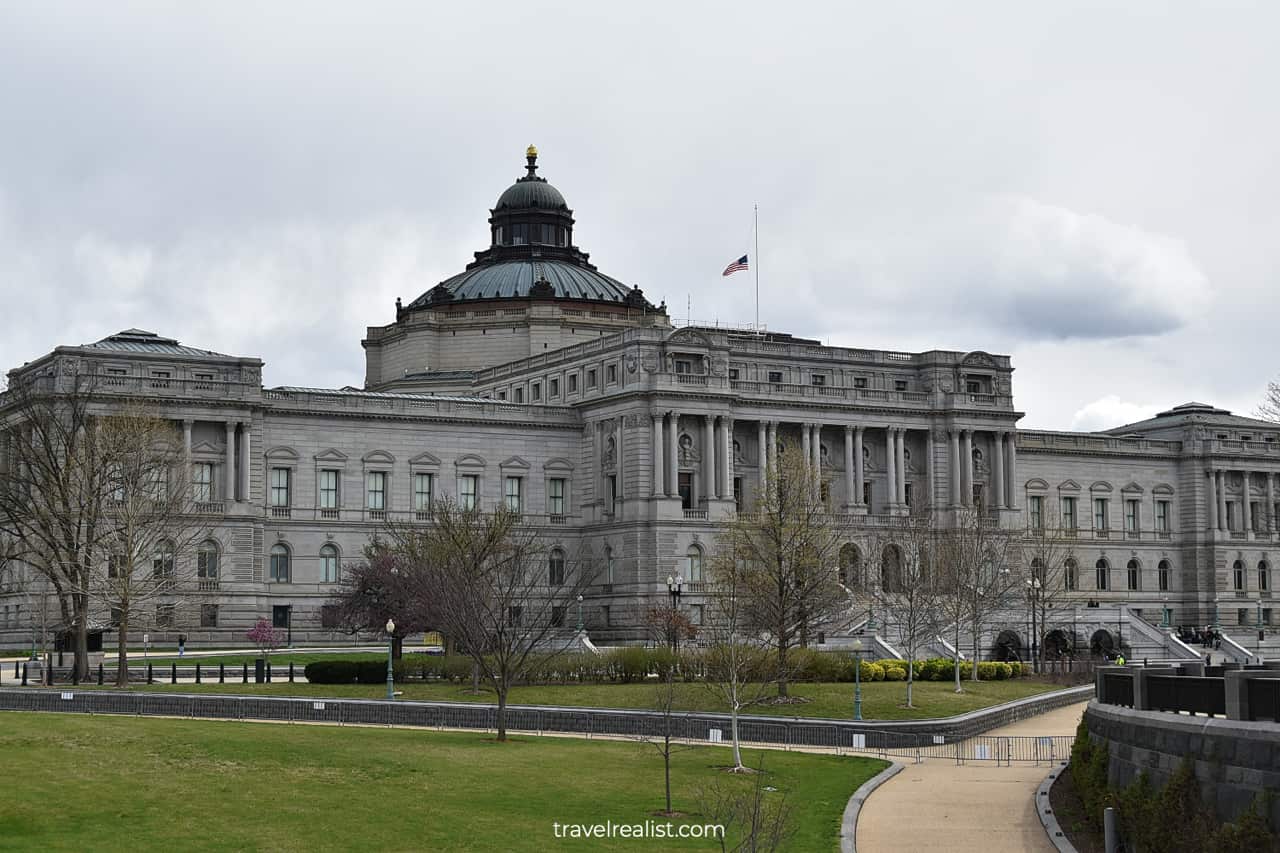
Sights & Places of Interest
Unless you come to the Library of Congress for research, the Thomas Jefferson Building is the main attraction. Its dome and columns are a sight to see from the United States Capitol grounds.
If you think this building is stunning outside, wait till you visit its halls. Massive arches, stained glass windows, sculptures, and domed ceiling await the visitors to the Main Library.
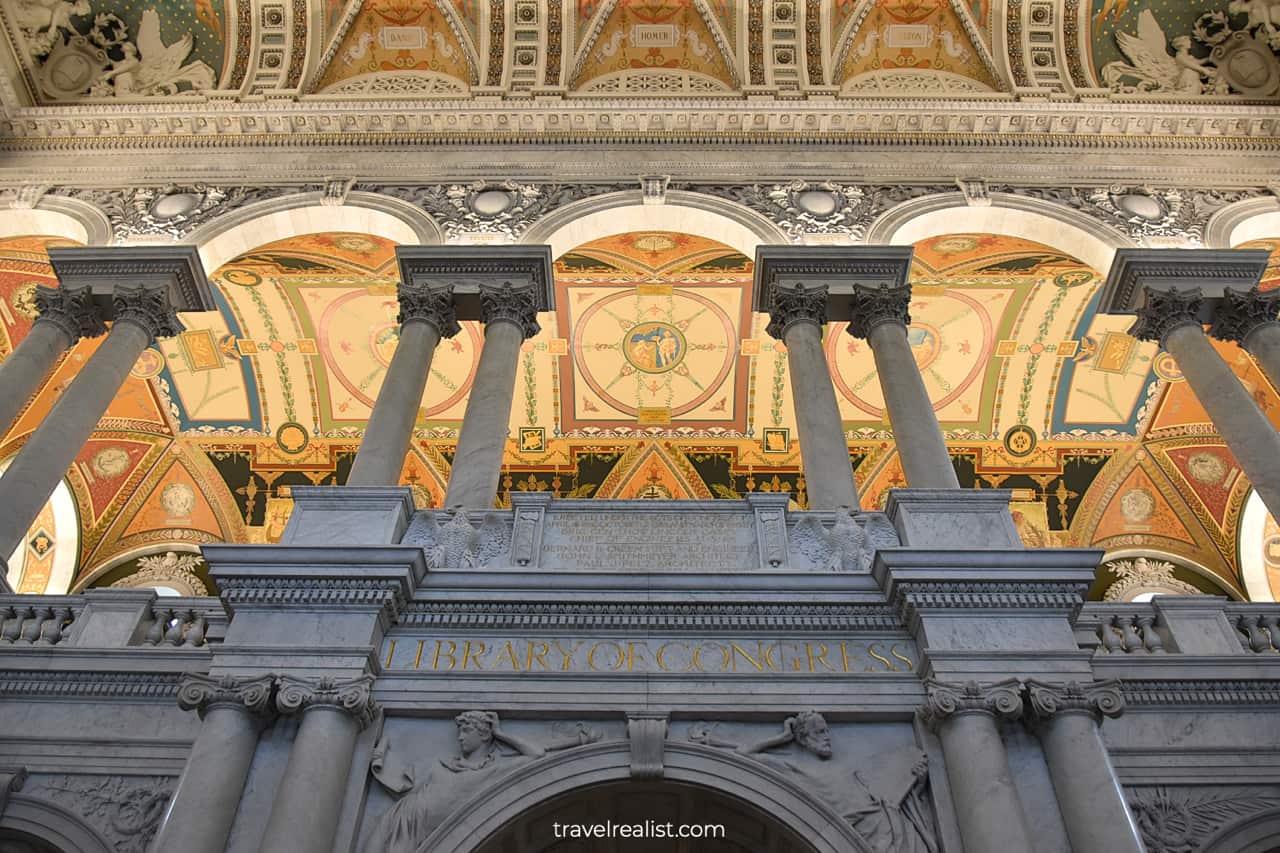
As you wander the halls, you might forget that you are in a library. The Thomas Jefferson Building is so scenic that you will feel as if you are visiting a museum.
The next sections of this Library of Congress Visitor Guide describe a visit to the Main Library. You will see the Great Hall, Main Reading Room, and everything in-between.
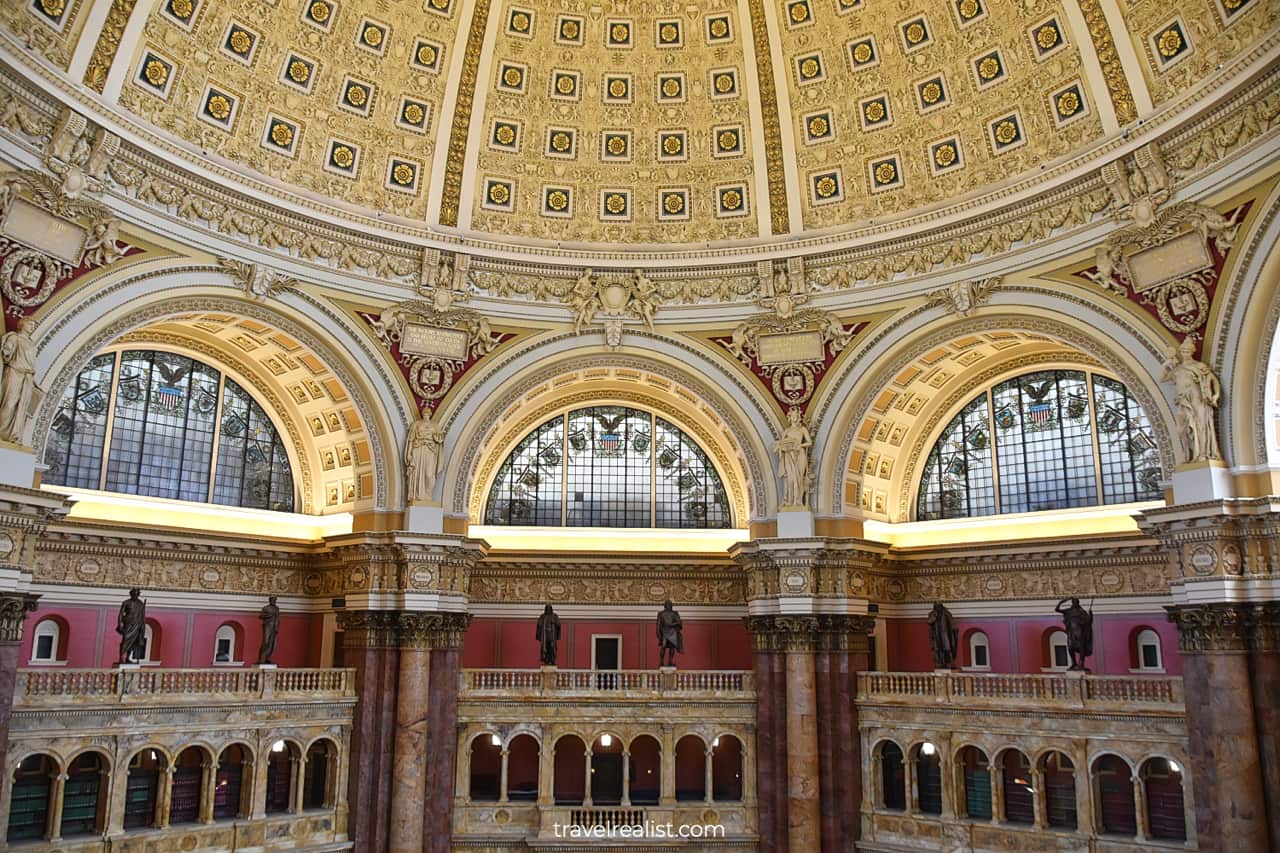
1. Great Hall
You will find yourself on the ground floor of the Library when you enter the building. It is home to a Library Shop, restrooms, and coat check. You need to take the stairs or an elevator to the first floor.
The Great Hall is certain to make you speechless. The arches, columns, staircases, and floor are all made of white marble. This material makes the wall inscriptions stand out.
But the rest of the ceiling has colorful paintings. They have bright red, orange, yellow, and green colors. You simply do not expect such a riot of color in a government building.
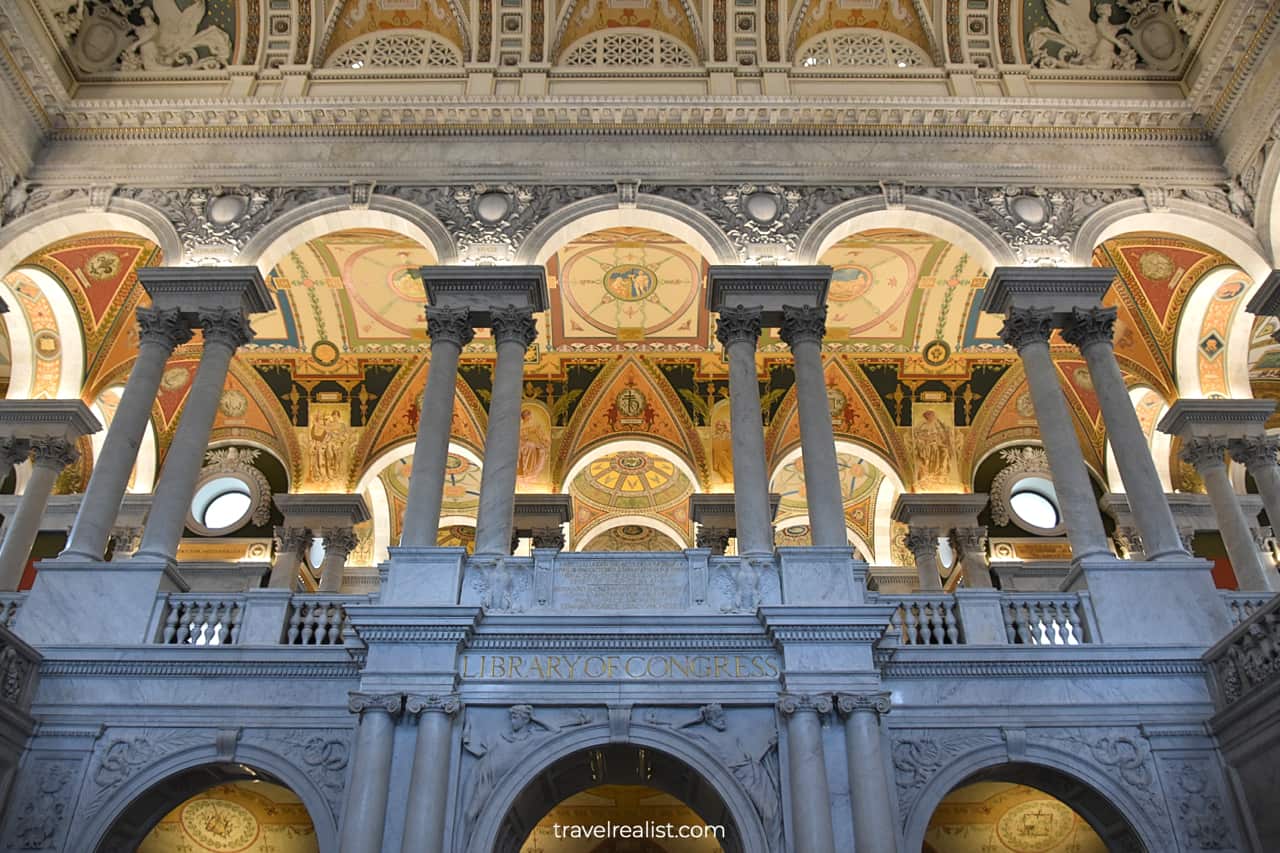
The first floor of the Great Hall is the best place to admire the ceiling of the Library. You could get a clear view of the six stained glass skylights. These square panels let natural light into the building.
A few symmetrical patterns surround the glass panels. Together with the paintings on the coved ceiling, they create a magnificent picture. It will be difficult to take your eyes of this ceiling.
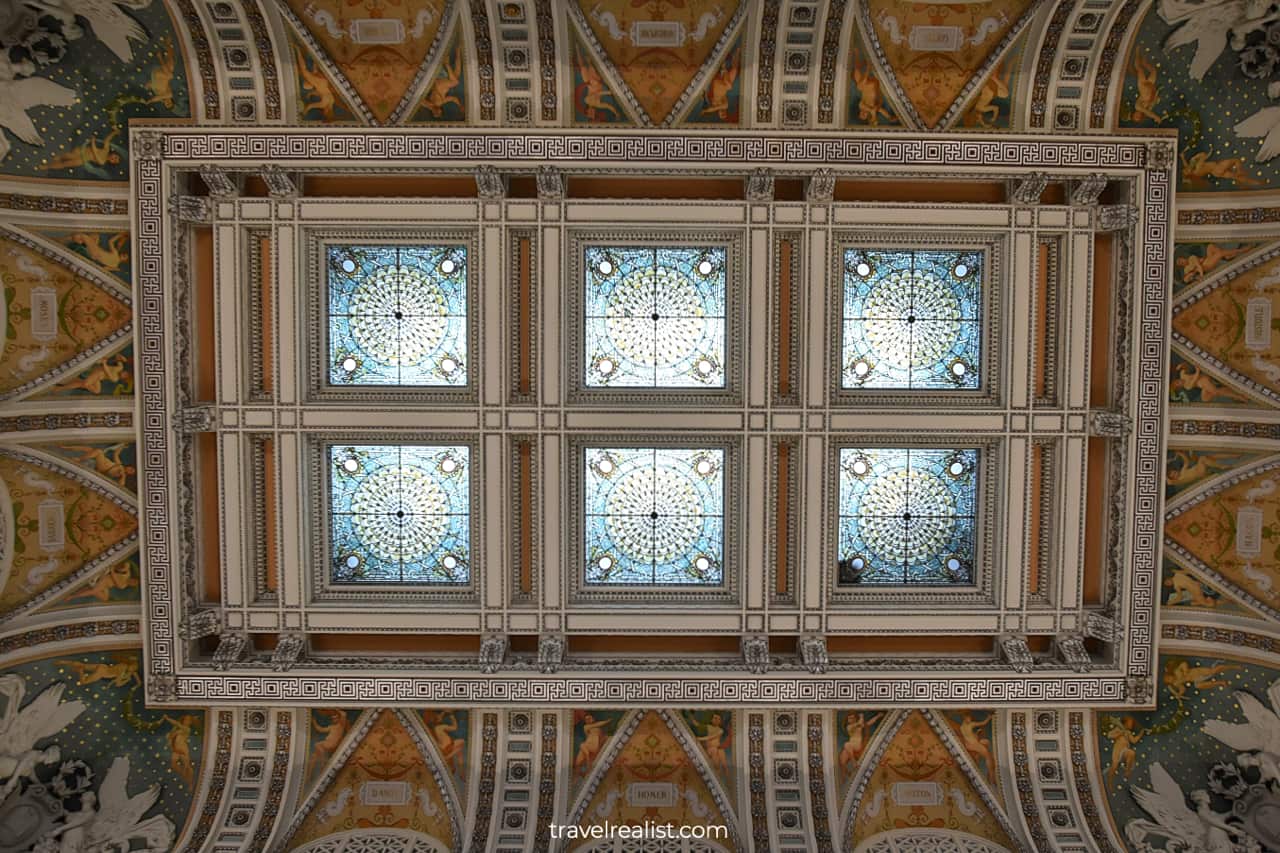
2. Gutenberg Bible
You might not feel like cutting your Great Hall exploration short. But there is one more display on the first floor that deserves your attention. It makes sense to visit it first before continuing to the other floors.
A copy of the Gutenberg Bible is on display in the hall behind the Commemorative Arch. A chance to see the first printed book in the world is a worth a short detour.
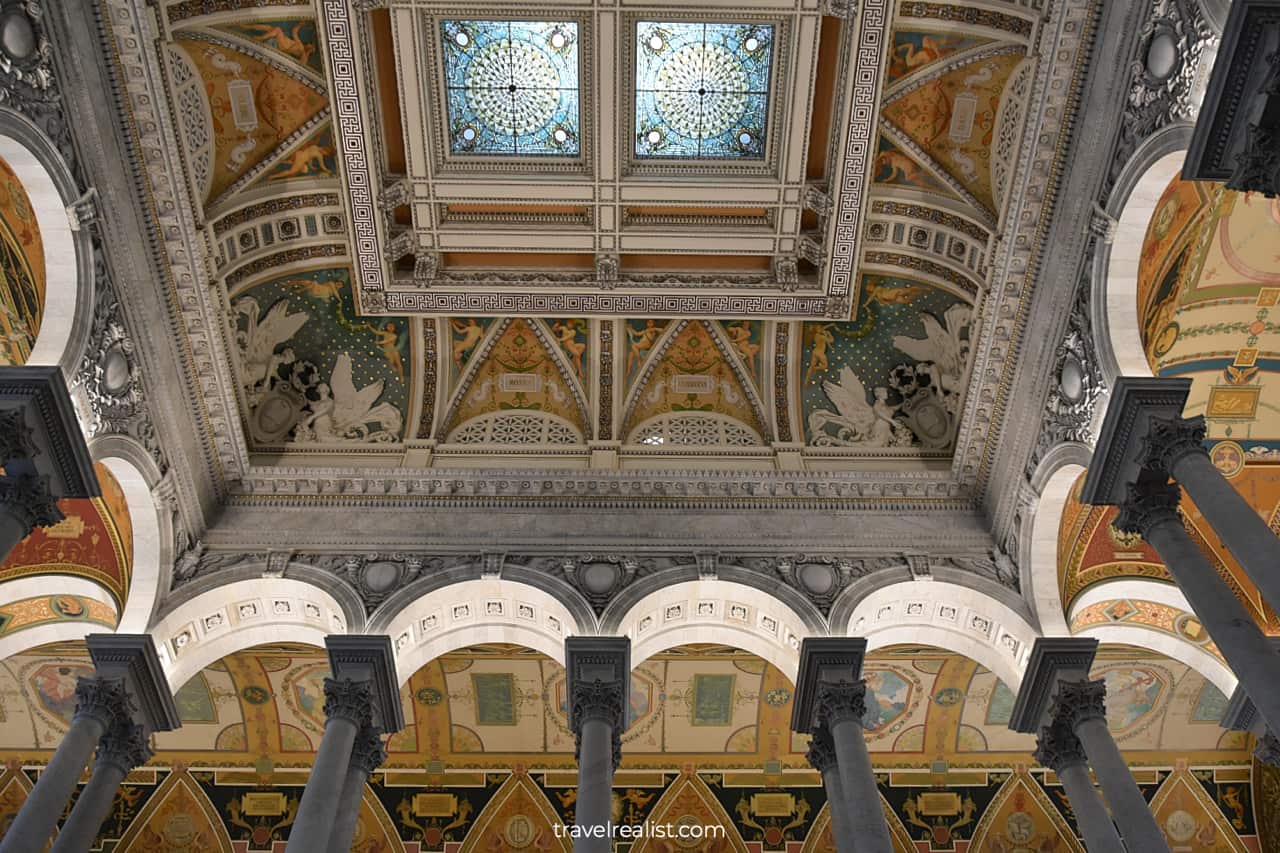
3. Mezzanine
You should take either of the Great Hall stairs to the Mezzanine. Take a moment to study a bronze statue. A female figure with a light torch celebrates U.S. contributions to science and progress.
This floor also brings you closer to the ceiling paintings. This is a unique chance to study the patterns and the plaster decorations up close.
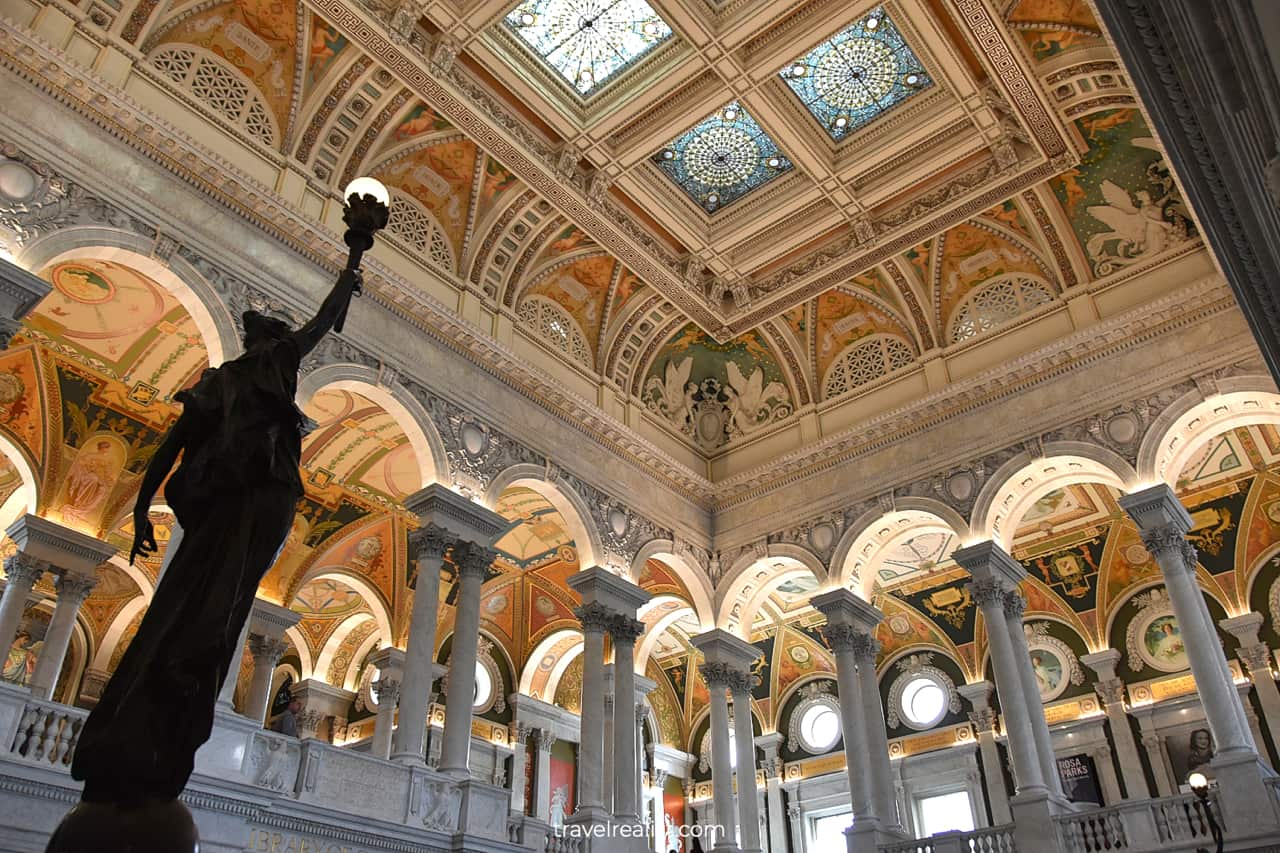
4. Printers’ Marks
Once you look closer, you will see that most triangular paintings are, in fact, printers’ marks. These marks were printed on books and manuscripts. Each mark was unique and belonged to a publishing house.
The printers’ marks were similar to copyright today. They protected the publishing house from plagiarism. The marks also helped create trust and promote the brand as a form of advertising.
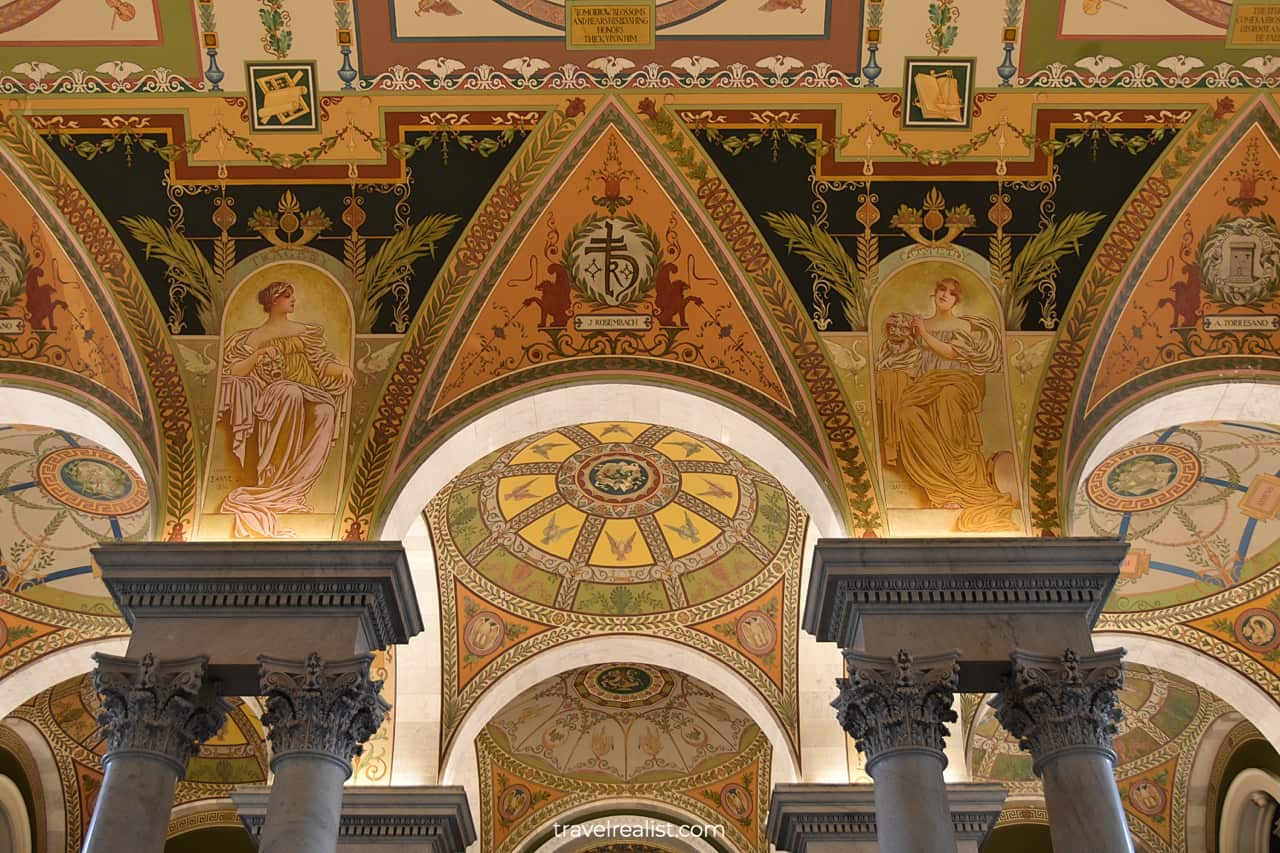
You could see all 56 printers’ marks in the Great Hall as you walk its passages. While the marks have a few common items, they each have a distinct pattern.
But unless you study them for a while, it might be difficult to see these subtle differences. Book readers could only tell the publishing house because the books were scarce back in the day.
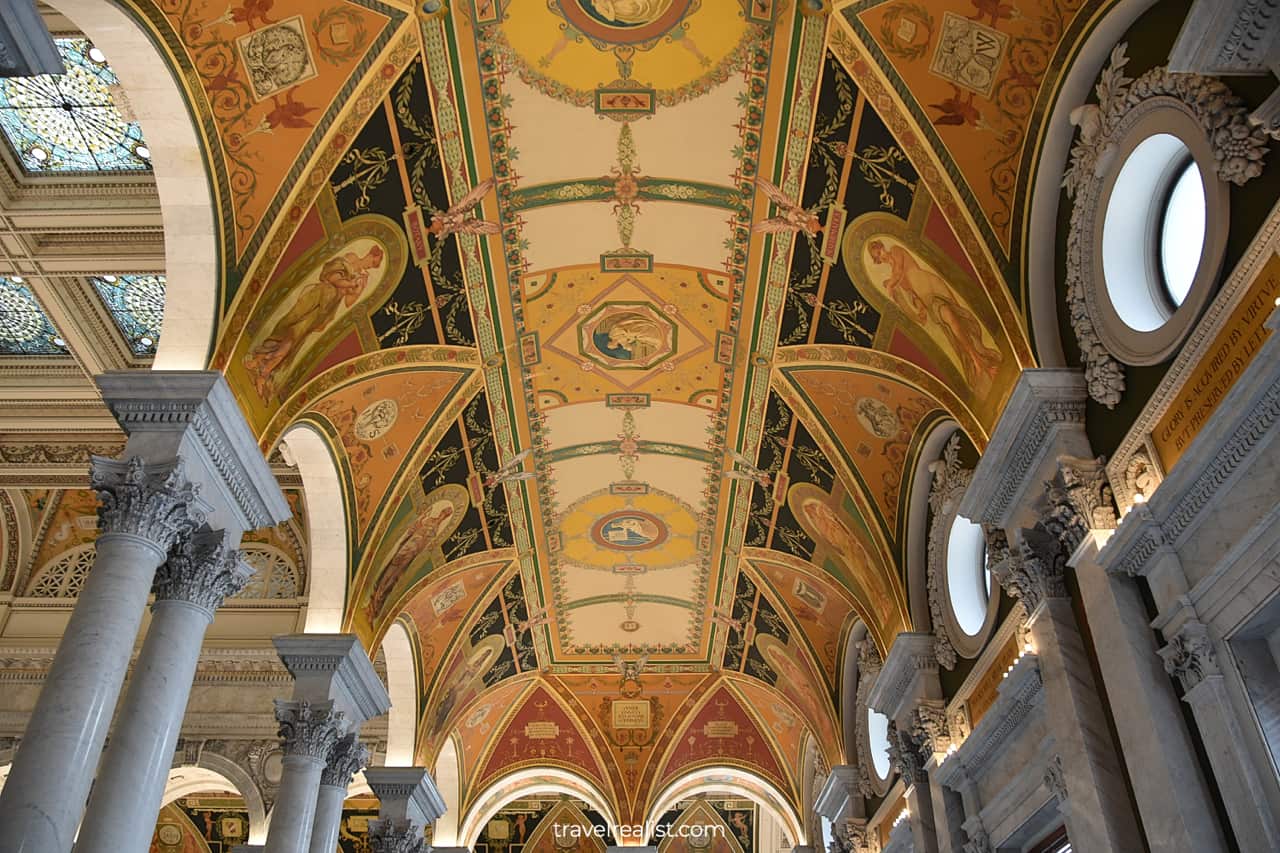
5. Minerva Mosaic
Most visitors to the Library of Congress come to see the Great Hall and the Main Reading Room. You cannot enter the latter unless you are a researcher. But you could take another staircase to an overlook.
You should take a few moment to admire a large mosaic as you go up the stairs. The mosaic shows Minerva, the Goddess of Wisdom. It is one of the most scenic displays in the Library of Congress.
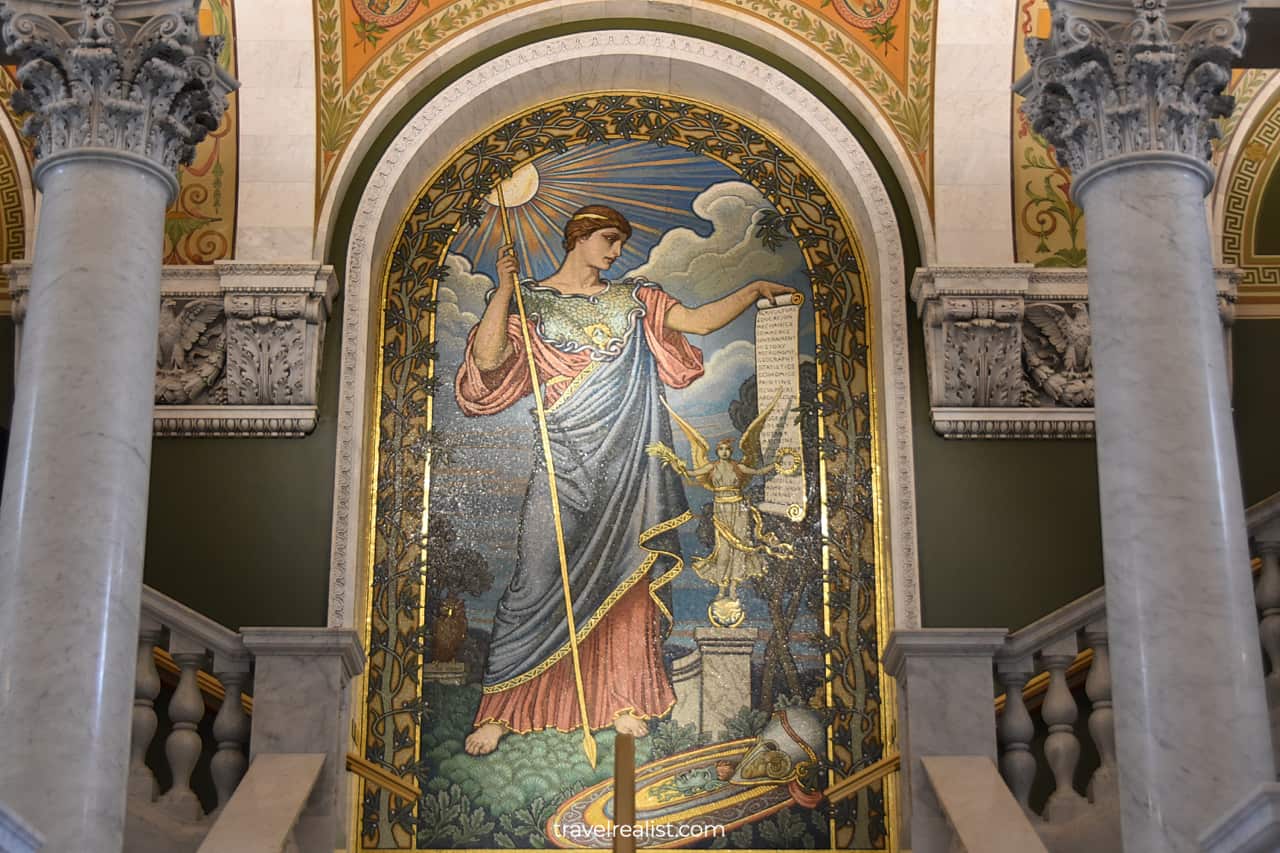
This staircase gives you a chance to see the Great Hall from a different angle. All rows of columns and arches will be in perfect alignment. You would see a perfectly executed design on display.
Keep in mind that the staircase is quite narrow and steep. Try to admire the Mosaic and the Great Hall fairly quickly. This way, you will avoid creating a line of visitors who wait to get a picture.
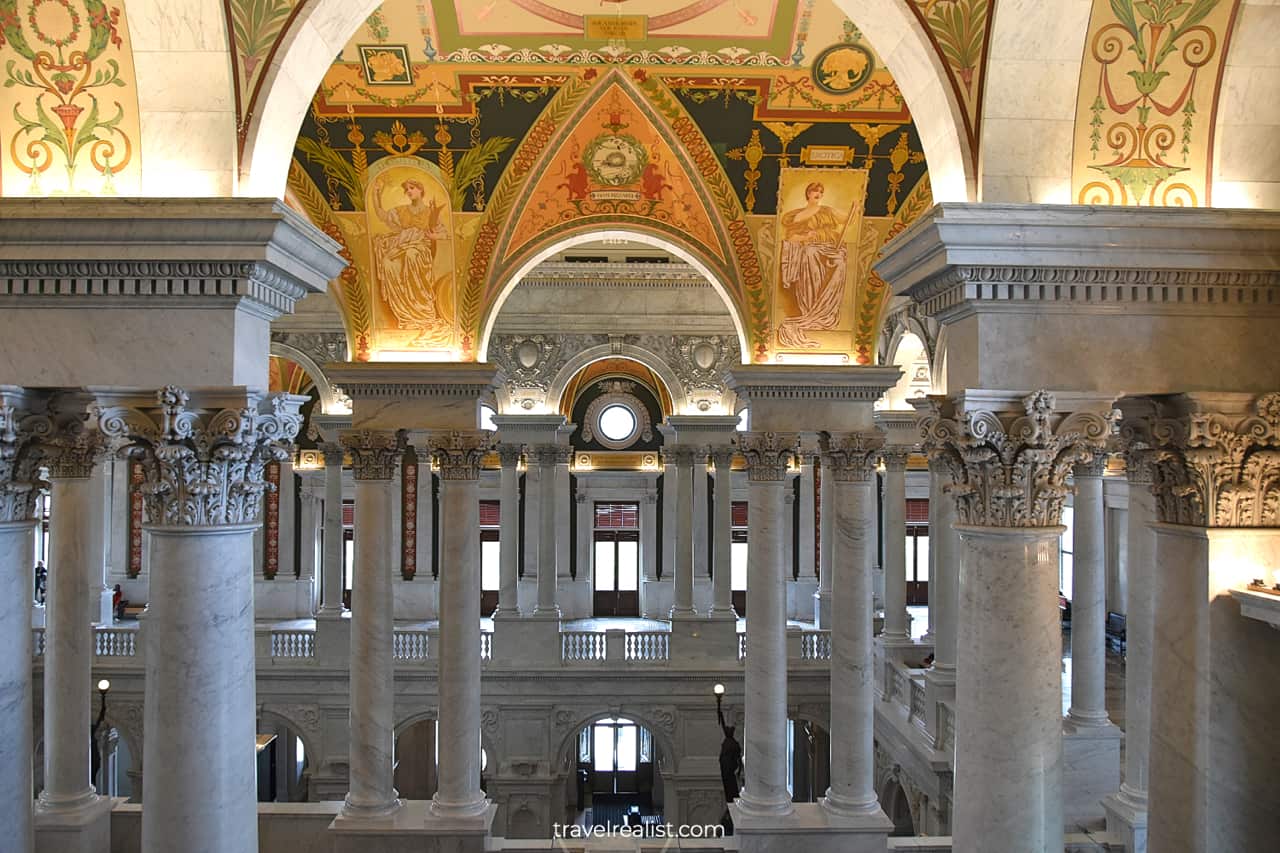
6. Main Reading Room
You will arrive at the Main Reading Room overlook shortly after passing the Mosaic. This round room is another highlight of the Thomas Jefferson Building.
You are certain to notice 16 bronze statues. Only two of the statues are at the Main Reading Room overlook. Others would be too far to study from the viewpoint.
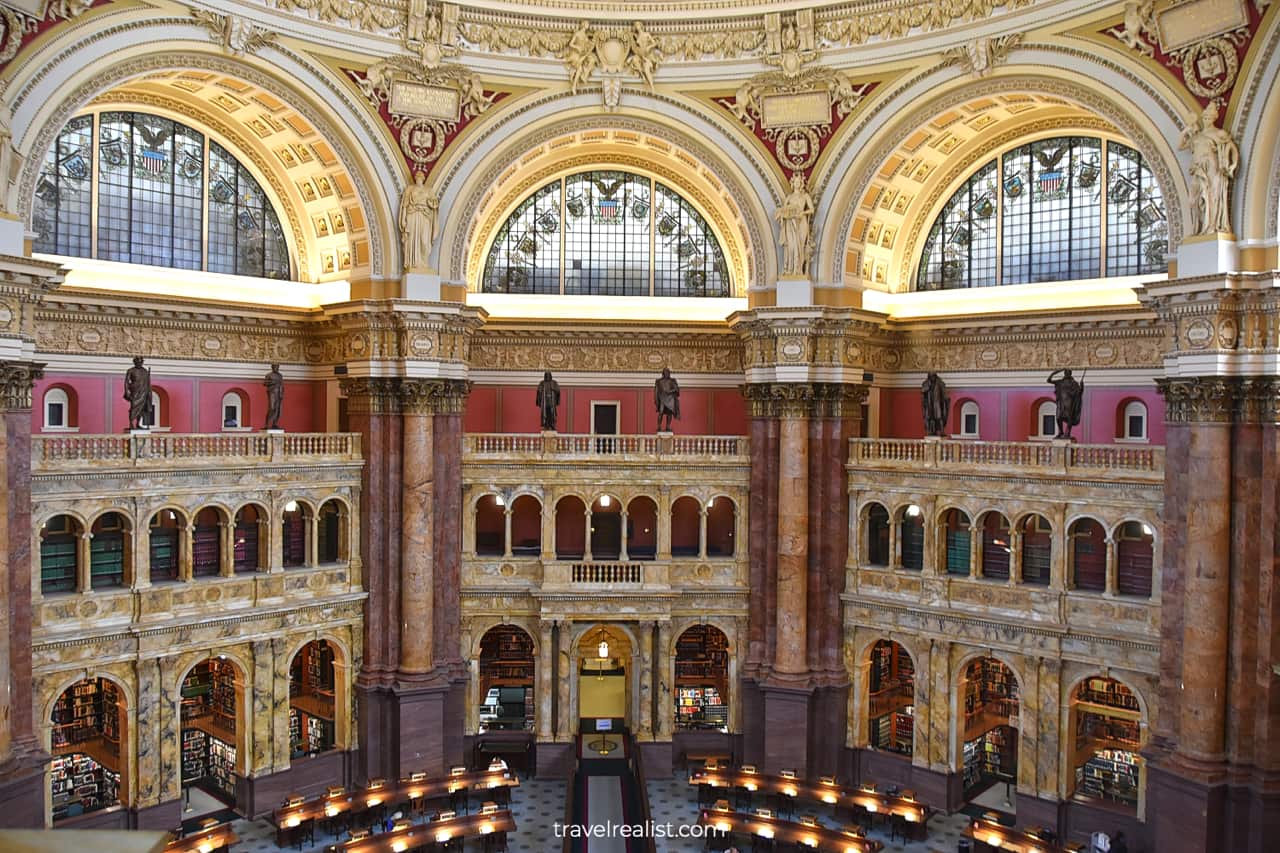
Eight marble columns support a massive 195-ft (59-m) dome. The gilded dome could compete with the neighboring United States Capitol building.
You might be able to see the interior of the cupola if you have good eyesight. The Cupola provides natural light to the Main Reading Room, alongside the stained glass windows.
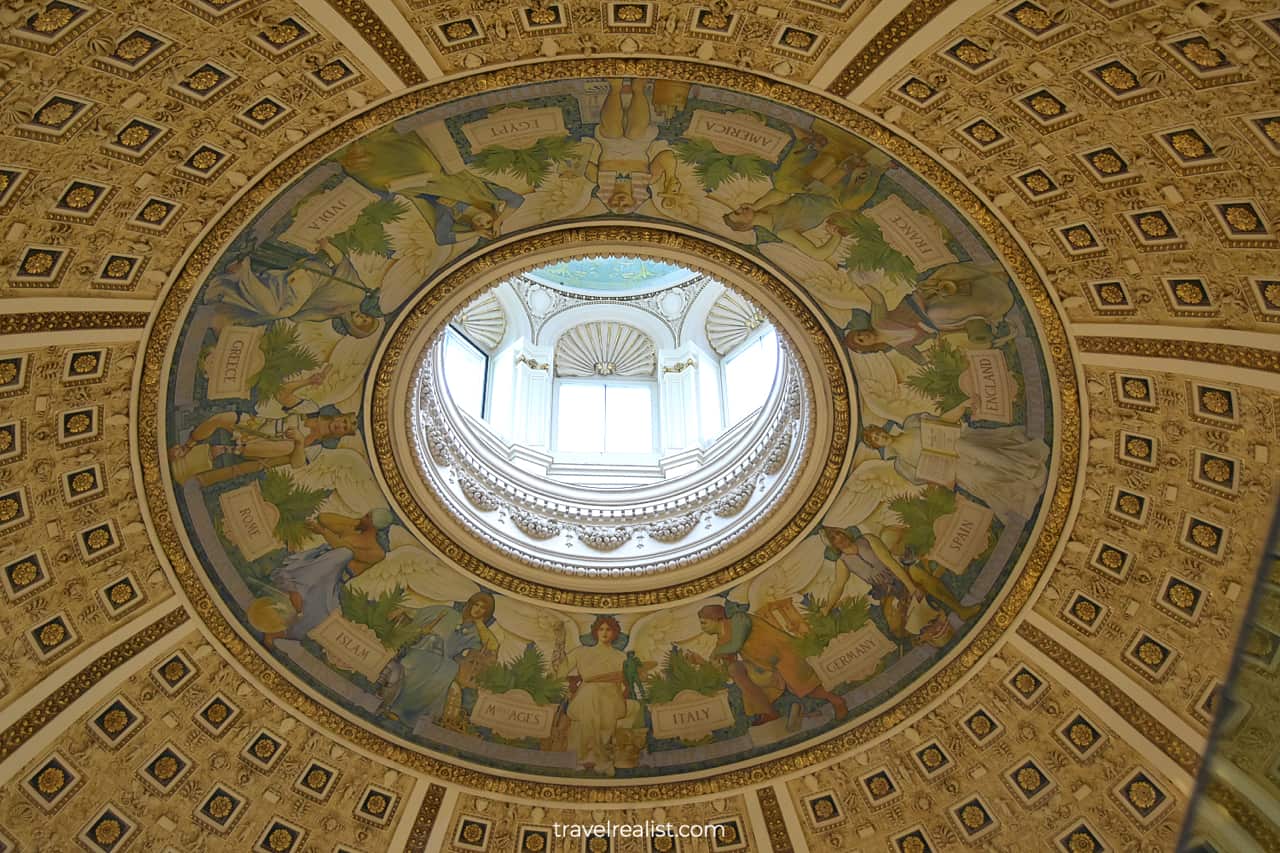
7. Southwest Gallery
You should return to the Mezzanine after a visit to the Main Reading Room overlook. The Galleries are the next thing for you to see on this floor of the Library.
Both the Southwest and Northwest Galleries house special exhibits. There might be a different collection on display if a few years pass between your visits to the Library.
The Southwest Gallery has an impressive barrel vaulted ceiling. There are two murals above the doorways. The Arts and The Sciences murals fit right in inside the Library building.
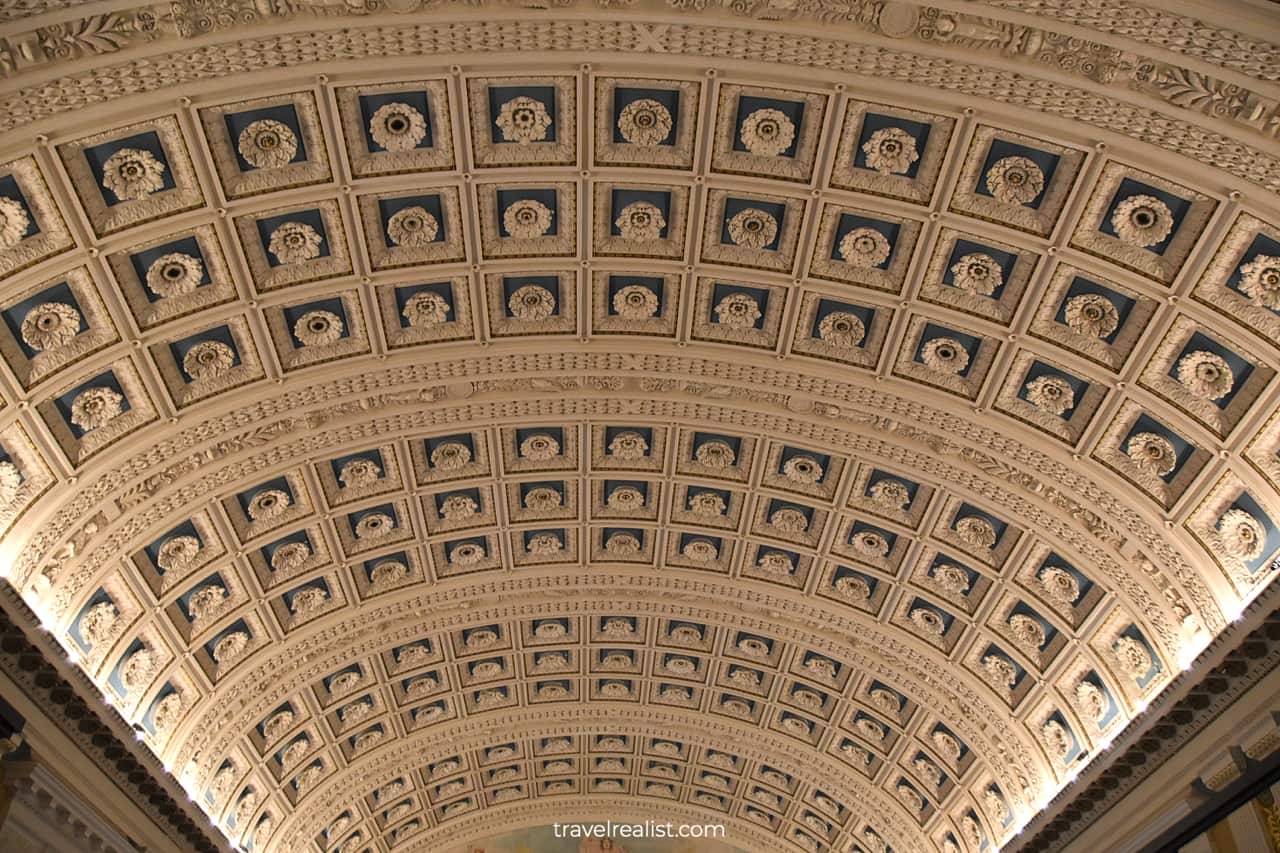
8. Thomas Jefferson’s Library
As you make your way through the Southwest Gallery, you should make a stop at the Southwest Pavilion. It is home to the Thomas Jefferson’s Library exhibit.
The Thomas Jefferson’s Library in the Thomas Jefferson Building of the Library of Congress sounds quite confusing. Nobody would blame you if you get it wrong.
This exhibit has a few bookcases with protective glass. The bookcases create an octagon. They house books from the Thomas Jefferson’s Library.
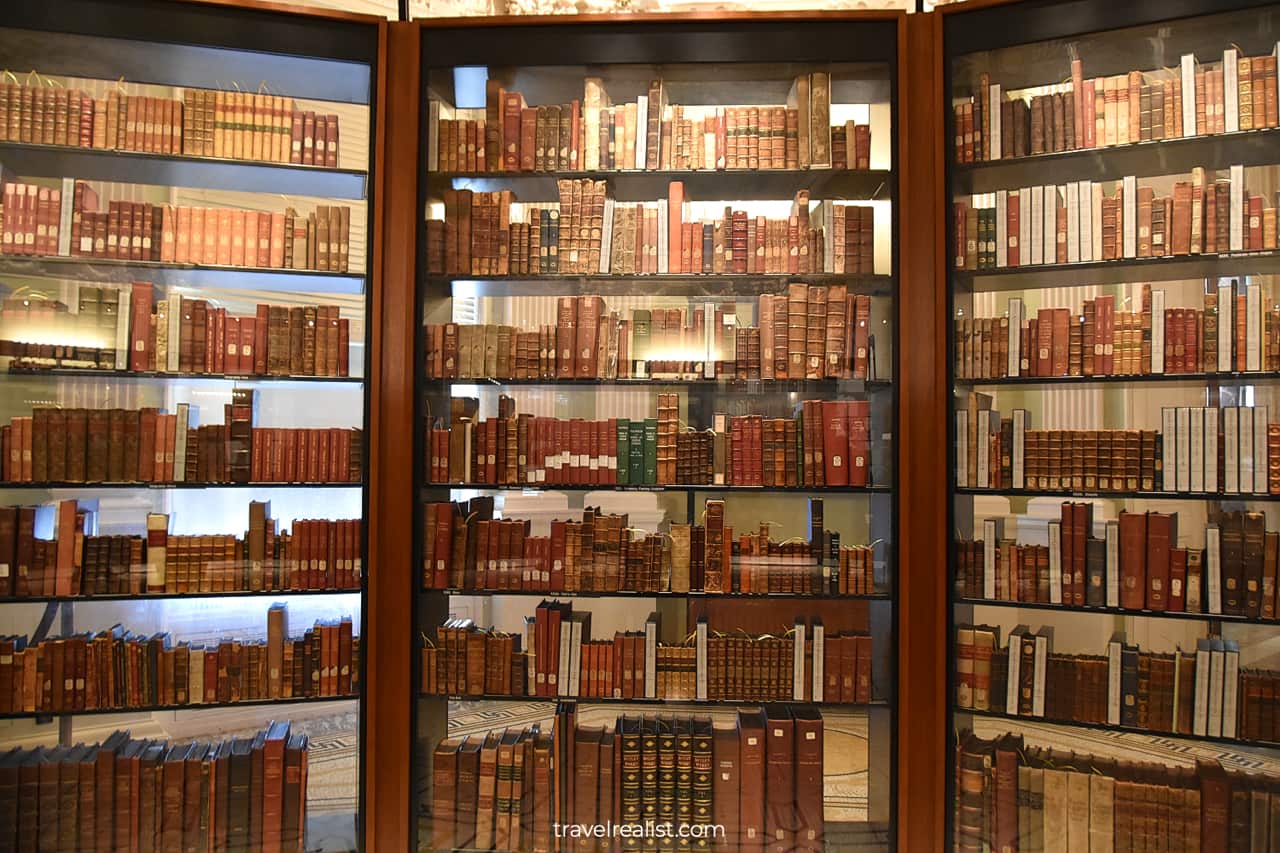
Take a look up after you finish exploring the exhibit. The pavilion’s domed ceiling has another mural. You will see four female figures.
They represent courage, valor, fortitude, and achievement. According to the artist, these qualities tie back to the four development stages for a nation.
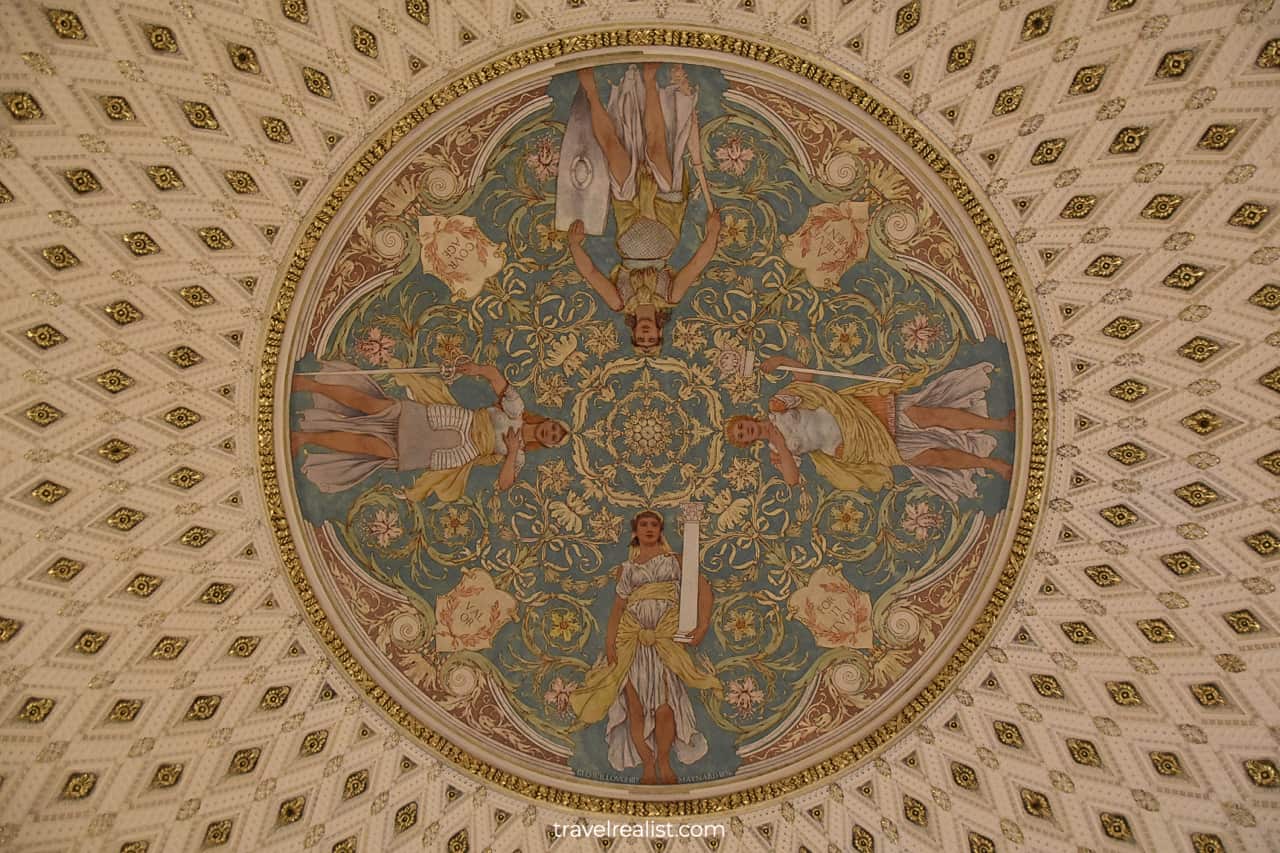
9. Northwest Gallery
The Northwest Gallery is quite similar to the Southwest Gallery. You will also see a barrel vaulted ceiling and two murals in this room.
But the ceiling pattern and lighting give the Northwest Gallery a different look and feel. The War and Peace murals show two plots as old as the human history.
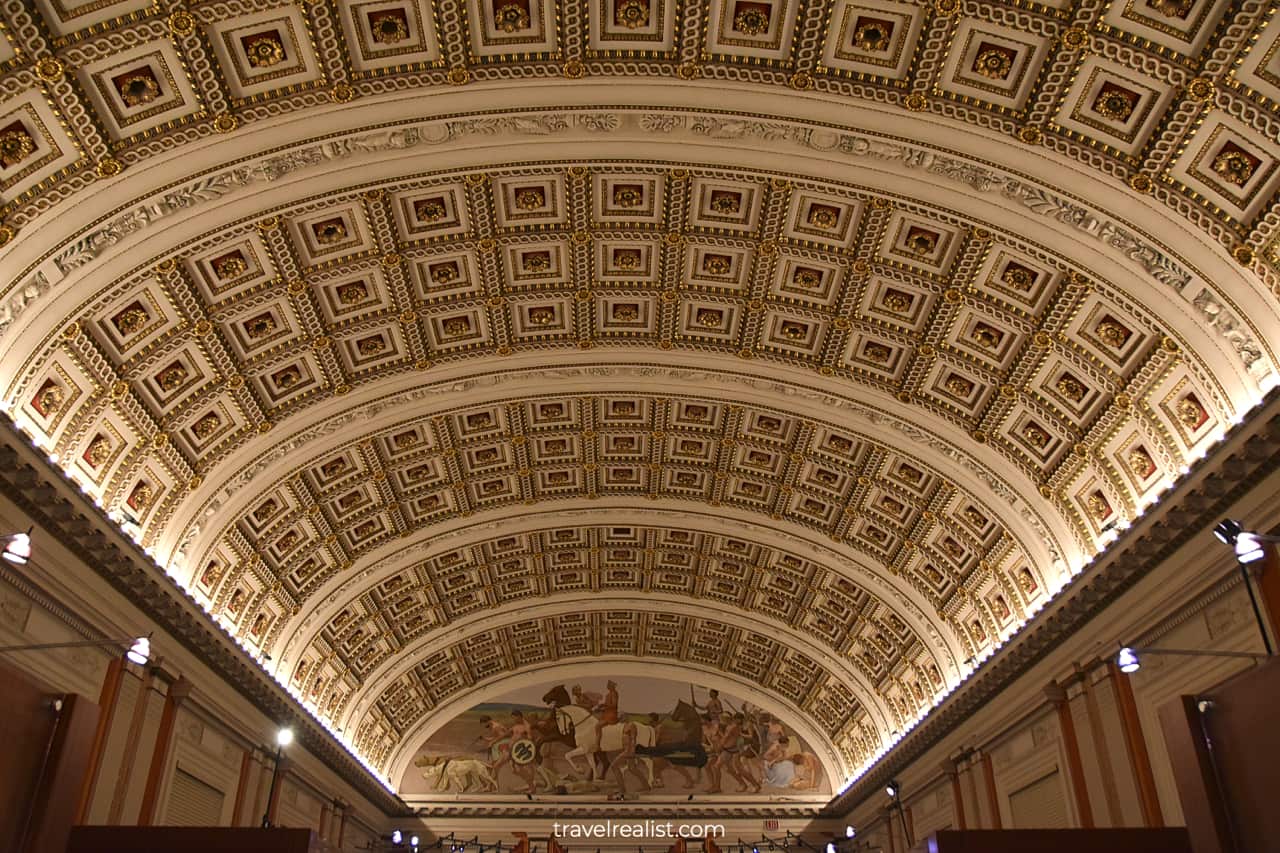
The Northwest Gallery is the last room to explore on the Mezzanine floor. Before you finish your visit to the Library of Congress, take a look from one of the windows.
You will enjoy a nice view of the United States Capitol. This 1800 building is still the symbol of the nation some 200+ years later.
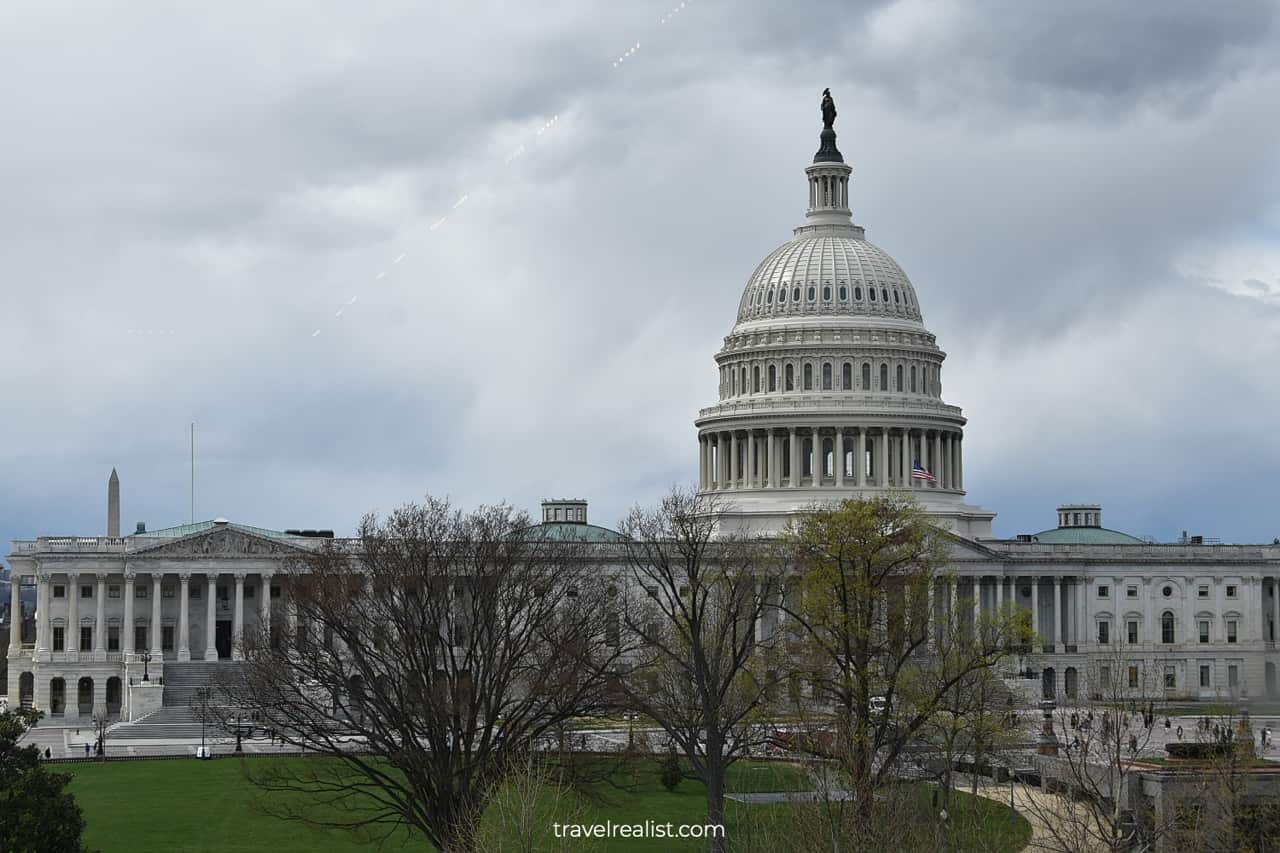
Continue with this Library of Congress Visitor Guide. You will learn more about ways to get to the sights, entrance requirements, and places to stay.
Getting to Library of Congress
The Library of Congress is in the easternmost part of the National Mall. It is a block east of the United States Capitol and a block south of the Supreme Court.
The Thomas Jefferson Building of the Library is also a block north from Capitol South Station. Public transport is the best way to reach the Library from most places in the Washington Metro Area.
Driving near the Library is not worth the hassle. Traffic jams and little parking make the trip not enjoyable. Leave the car at home or at your place to stay. This will save you a lot of headache down the line.
Out-of-state or out-of-country visitors need to fly to visit the Library of Congress. The capital of the United States has three major airports, DCA, IAD, and BWI.
Ronald Reagan National (DCA) Airport is the closest airport to the Library. A trip from this hub is under 30 minutes on subway. Take Yellow line to L’Enfant Plaza and transfer to Blue, Orange, or Silver lines.
You will pay just $2 on weekend and $2.45 on weekday to travel this distance. This is a bargain compared to the hourly and daily rates in the nearby parking garages.
Dulles (IAD) is the second closest airport. You just need to board a Silver Line train. This train brings you from the airport to the Library. This 62-minute trip costs $2 on weekend and $6 on weekday.
Baltimore-Washington (BWI) is the last airport to consider. This trip could take between 75 minutes and 2 hours. You need to take a bus, train, and subway from the airport.
The trains are less frequent than the subway. You also need to budget at least $9 per trip on a weekend. A weekday trip could cost $11 or more each way.
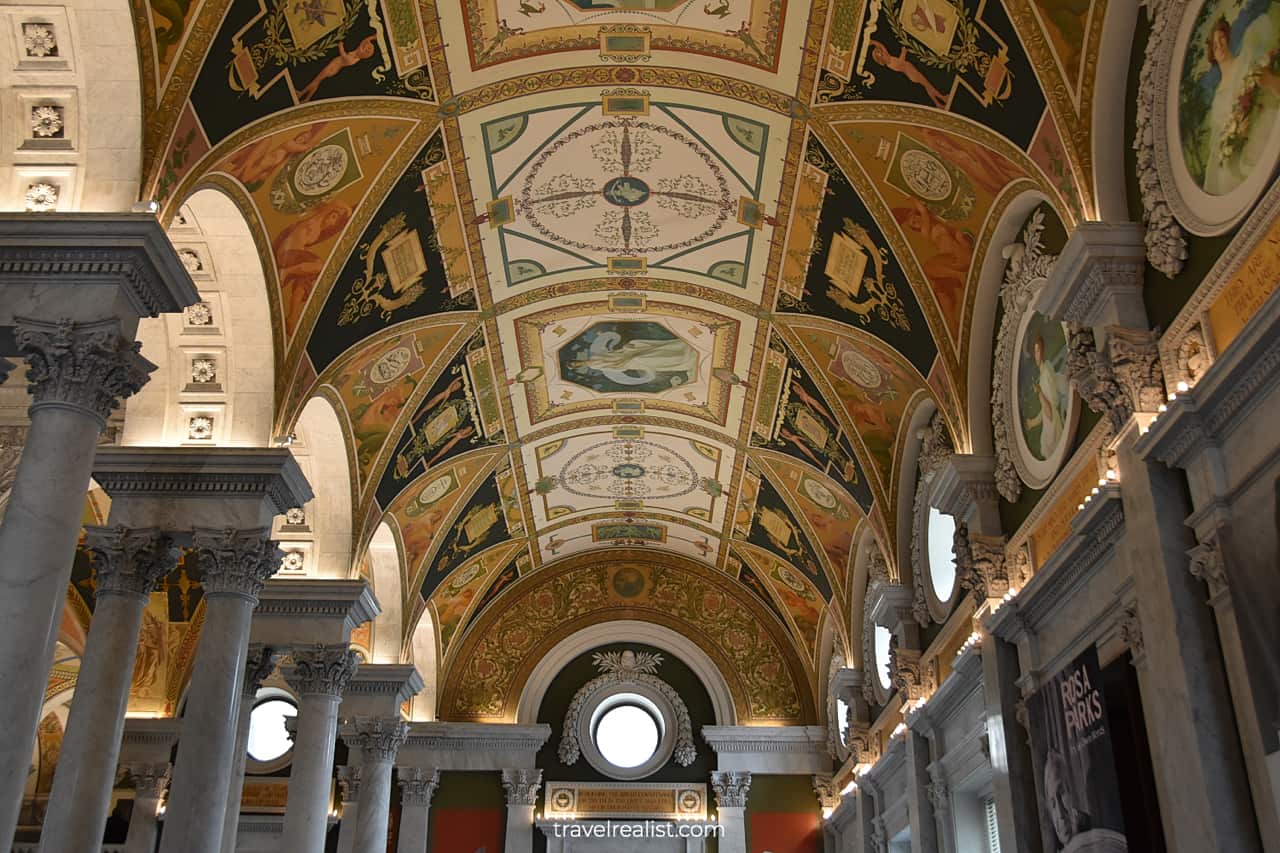
Where to Stay near Library of Congress
The Library of Congress is in the center of Washington, D.C. Therefore, you could choose from a lot of places to stay. Most of them are a short walk to the Library of Congress.
But high prices per night are a trade-off for this convenience. You cannot beat Capitol Hill Hotel when it comes to location. This place to stay is a 6-minute walk from the Library of Congress.
If you are looking for something more affordable, you need to find a place to stay further away. Navy Yard is one neighborhood to consider.
Take a look at Coda on Half, a Placemakr Experience and Thompson Washington DC, part of Hyatt. Both places to stay are a 30-minute walk from the Library.
Penn Quarter and Logan Circle are neighborhoods north of the Library of Congress. They are home to Motto by Hilton Washington DC City Center and Washington Plaza Hotel.
You might score a deal at other places to stay near the National Mall. But unless you book your stay well in advance, you might have to take subway to your hotel.
In this case, go across the Potomac River to Virginia. Arlington and Crystal City are worthwhile destinations. They are also close to DCA airport.
Check out Homewood Suites By Hilton Arlington Rosslyn Key Bridge and Residence Inn Arlington Capital View. Both hotels are amazing places to stay. They are worth a subway ride to the Library.
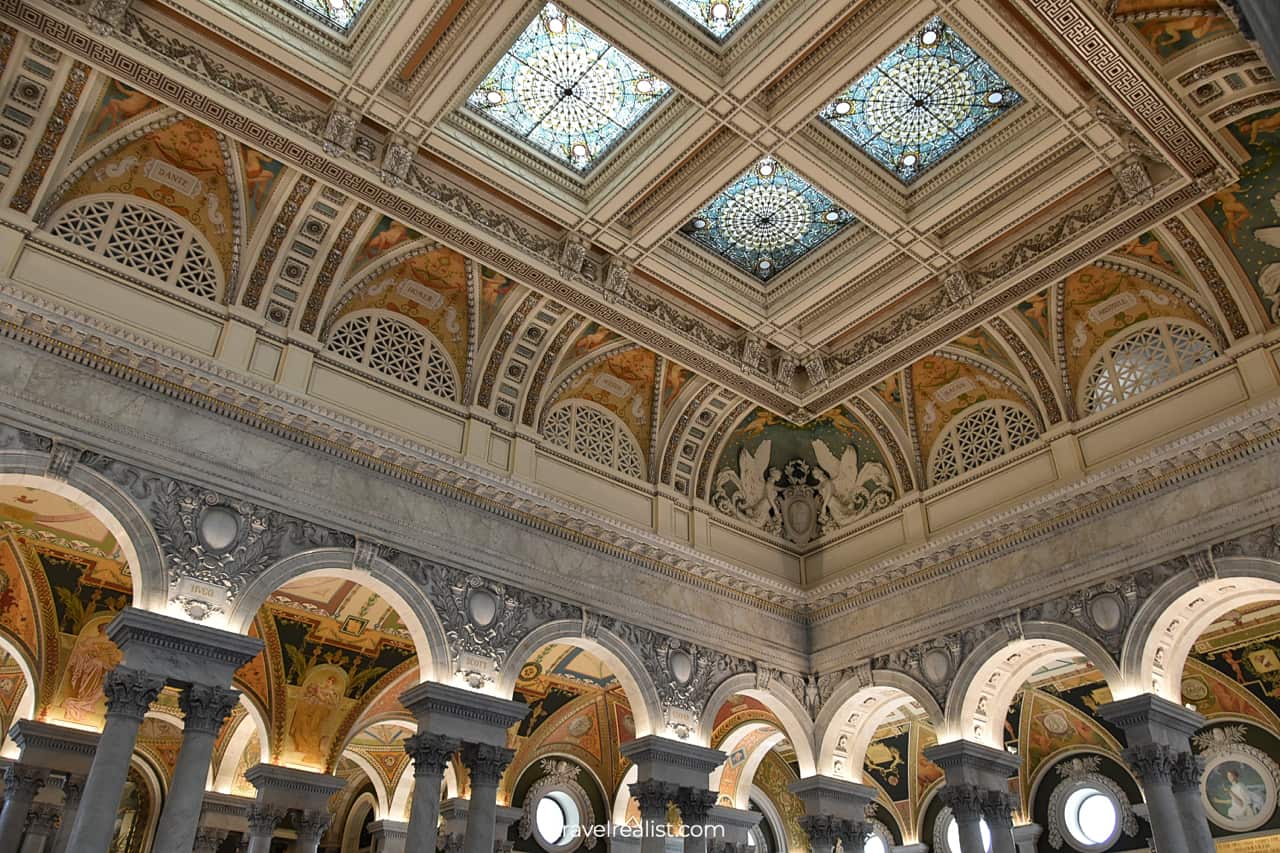
Entrance Requirements & Passes
The Library of Congress is open to visitors from 10 a.m. to 5 p.m. Tuesday to Saturday. Visitors could enter the Thomas Jefferson Building up to 30 minutes before closing time.
The Library is one of the most popular destinations of the National Mall. You cannot just walk into this library like with Boston Public Library or State Library of Victoria in Melbourne, Australia.
Instead, you need to get a free timed-entry ticket. This system helps the Library control visitor flow and ensure safety. But it could be a challenge if you do not plan your visit well in advance.
There are a few ways to get a ticket. You could reserve your ticket ahead of time. These tickets are available on a 30-day rolling basis. Take a note of your tour date. And check the website 30 days before.
If you failed to book a ticket in advance, you will have one more shot at getting them. A handful of tickets become available online at 9 a.m. the day of the visit. Most tickets could be gone shortly after 9 a.m.
The website of the Library of Congress has some issues. You might not be able to buy tickets if you access it via Chrome, Mozilla, or Safari browsers. Edge browser is the most reliable option.
Arrive at the Thomas Jefferson Building about 10 minutes before your time. This way, you will spend the least time in line. If the line is long, you might have to stand with no protection from rain, wind, and snow.
Library staff will start letting visitors with tickets in a few minutes before the posted time. Get ready to clear security similar to the Statue of Liberty. Once inside the building, you could take a free brochure.
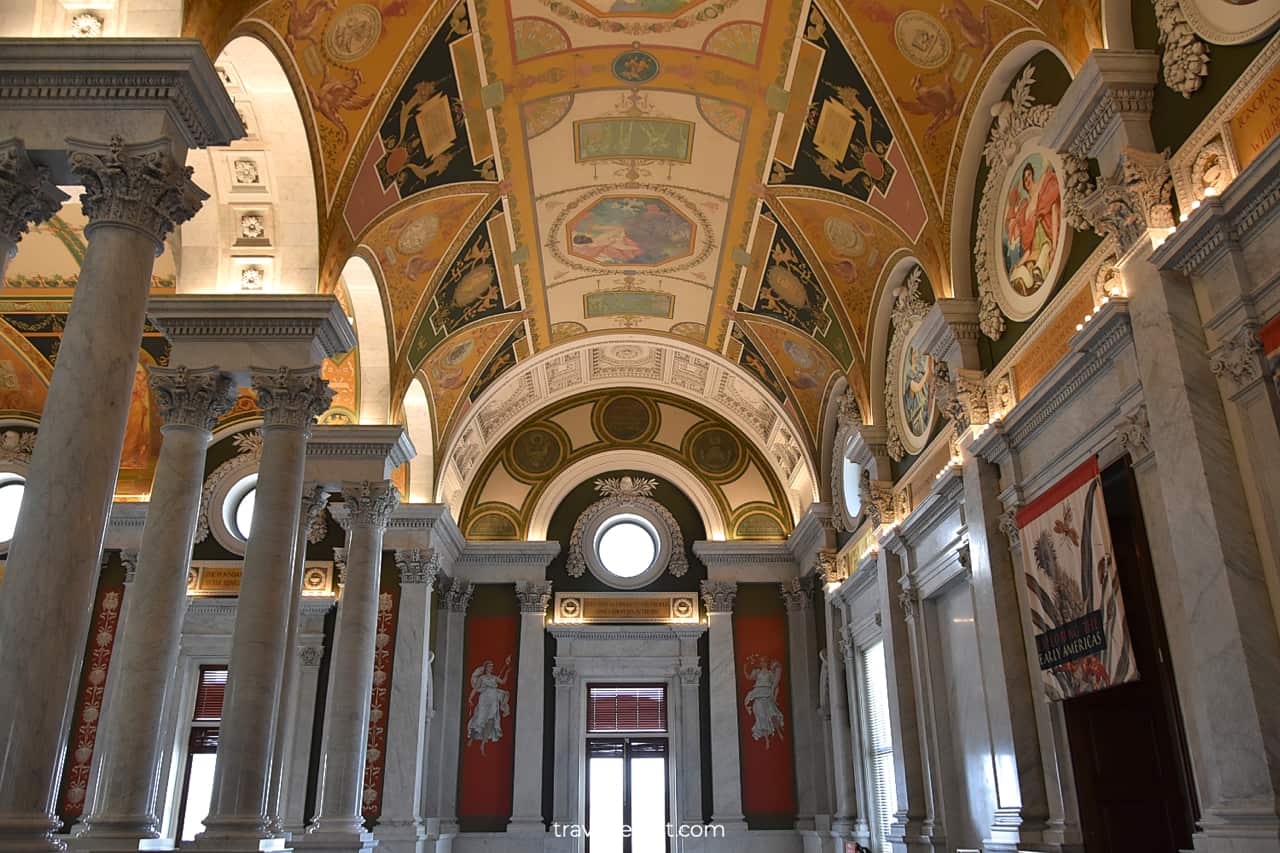
Takeaways: Library of Congress Visitor Guide
The Library of Congress is one of the most beautiful buildings at the National Mall in Washington, D.C. Murals and arches, printers’ marks and mosaics make the Library a worthwhile destination.
You will enjoy a visit to the Thomas Jefferson Building if history, art, or architecture are your cup of tea. There are few buildings in the world that could rival the beauty of the Library of Congress.
It is a must-visit destination in the nation’s capital. You will remember your trip to the Library of Congress for years to come.
You should make an effort and get a timed reservation ahead of your visit. The ticket is free. But you need to have it to enter the building.
If you decide to visit the Library spontaneously, check this website at 9 a.m. the day of your visit. You should be able to get a same day ticket if you book it fast enough.
Take a look at this Library of Congress Visitor Video Guide. And visit the YouTube channel for the latest videos.
Frequently Asked Questions
There are a lot of things to see at the Thomas Jefferson Building of the Library of Congress.
– Admire the arches, murals, and ceiling of the Great Hall.
– Take a look at the Gutenberg Bible, a copy of the first printed book in the world.
– Enjoy the Main Reading Room from an overlook.
– Observe the details of the Minerva Mosaic.
– Find the differences between the Printers’ Marks.
– See historic books from the Thomas Jefferson’s Library.
– Visit the exhibits in the Northwest and Southwest Galleries.
– Get a glimpse of the United States Capitol.
You need to get a free timed reservation to visit the Library of Congress. You could secure a reservation in advance or at 9 a.m. the day of your visit. There is no admission to the Library without the reservation or outside of the listed time.
You could spend between 30 minutes and an hour exploring the Library of Congress. It is enough time to see the Great Hall, Main Reading Room, and Galleries.
There are a number of reasons to visit the Library of Congress in Washington, D.C.
– The Library of Congress is the oldest federal cultural institution in the United States.
– The Thomas Jefferson Building is among the most beautiful structures at the National Mall.
– A copy of the Gutenberg Bible, the first printed book, is on display in the Library.
– Ceiling, murals, mosaics, arches, and other exhibits are a sight to see.
– It is free to visit the Library of Congress.
You could visit the Library of Congress free of charge.
Safe realist travels!

